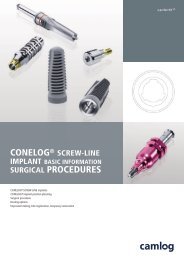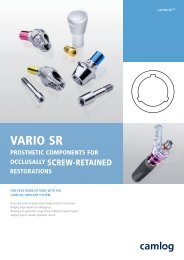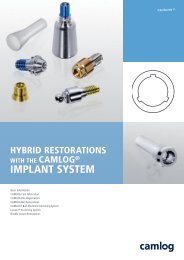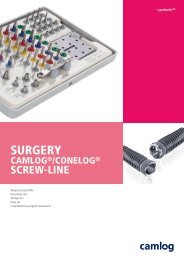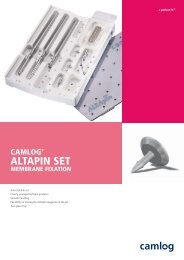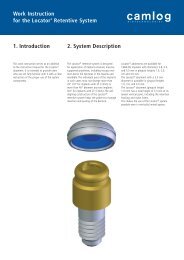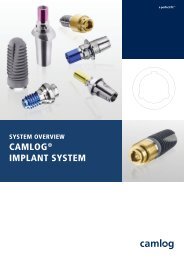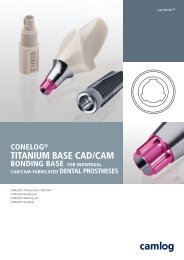CONELOG® Implant System Prosthetic Restorations - Camlog
CONELOG® Implant System Prosthetic Restorations - Camlog
CONELOG® Implant System Prosthetic Restorations - Camlog
Create successful ePaper yourself
Turn your PDF publications into a flip-book with our unique Google optimized e-Paper software.
SYSTEM INTRODUCTION<br />
GENERAL GUIDELINES FOR THE FABRICATION OF<br />
IMPLANT-SUPPORTED PROSTHETICS<br />
Modern implant prosthetics is now an established component of dentistry.<br />
The expectations and demands of patients are steadily increasing. Therefore,<br />
the ultimate goal of modern implant-supported treatment concepts is<br />
for full esthetic, functional, phonetic, and psychosocial rehabilitation. This<br />
applies equally to replacements of lost single incisors associated with<br />
trauma and the complex rehabilitation of periodontally compromised remaining<br />
teeth or the treatment of an edentulous heavily atrophied maxilla<br />
and mandible.<br />
Increasingly higher demands for quality and specialization require a multidisciplinary<br />
team approach to combine the members acquired knowledge<br />
and experience. Modern implant-supported restorations need a high level<br />
of attention to detail and clinical experience. This is true equally for the<br />
restorative dentist, the surgeon, the dental technician, and the dental office<br />
support staff such as the nurse, hygienist, and chair assistant. The<br />
CAMLOG team concept takes all of these demands into consideration. The<br />
sequence of treatment procedures is structured, and specific procedures are<br />
clearly assigned to specific team members once the joint planning phase is<br />
complete.<br />
The implant-supported prosthetic restoration should be designed as simple<br />
and as safe as possible in regards to planning and fabrication. The required<br />
number of implants, as well as their length and diameter are determined<br />
based on the restoration planned later and the available bony implant site.<br />
The pre-implantation planning should be oriented exclusively to prosthetic<br />
needs (backward planning).<br />
The patient is the focus of the implantological restoration. The patients<br />
needs and desires must play a part in the fabrication of the prosthetic restoration.<br />
This also requires taking into account anatomical relationships<br />
and conditions. Natural teeth are attached elastically by the periodontium<br />
to the alveolar bone. However, implants are rigidly anchored to the alveolar<br />
bone by the ankylotic connection to the bone substance. Mastication<br />
forces placed on implant-borne crown and bridge restorations are transferred<br />
directly to the bone. For this reason, the mastication forces should<br />
be transferred by a possible physiological process in the form of a suitable<br />
occlusion design thus supporting the long-term success of the integrated<br />
implants.<br />
CONELOG ® IMPLANT SYSTEM<br />
PROSTHETIC RESTORATIONS<br />
This can be achieved in the posterior occlusal area with a surface area of<br />
approx. 1 mm² that allows lateral freedom of movement of approx. 1 mm<br />
in habitual intercuspation. This makes it possible for the cusps to glide<br />
smoothly between the retrusive contact position (centric occlusion) and the<br />
maximum intercuspal position called «freedom in centric». In conjunction<br />
with a premolarized forming, overloads can be avoided. Extreme cusp<br />
formations should be avoided due to dentition that is too strong and vertical<br />
mastication forces affect the implant/antagonist axis preferably physiologically.<br />
Guidance functions of crown restorations on individual implants<br />
can lead to lateral force affects that are too strong and should be avoided.<br />
Appropriate planning should occur (e.g. wax-up) in advance.<br />
RECALL<br />
Resilient supported full dentures with retention devices should be regularly<br />
checked in three-month intervals after insertion. When harmful movements<br />
of the prosthesis occur, they can be eliminated promptly by through appropriate<br />
measures (occlusion check, activation / replacement of the matrices,<br />
relining). Patients with inadequate oral hygiene are remotivated and instructed<br />
again as part of oral hygiene and denture care. For patients with<br />
good oral hygiene, the intervals between the functional and hygiene checks<br />
can be extended.<br />
5




